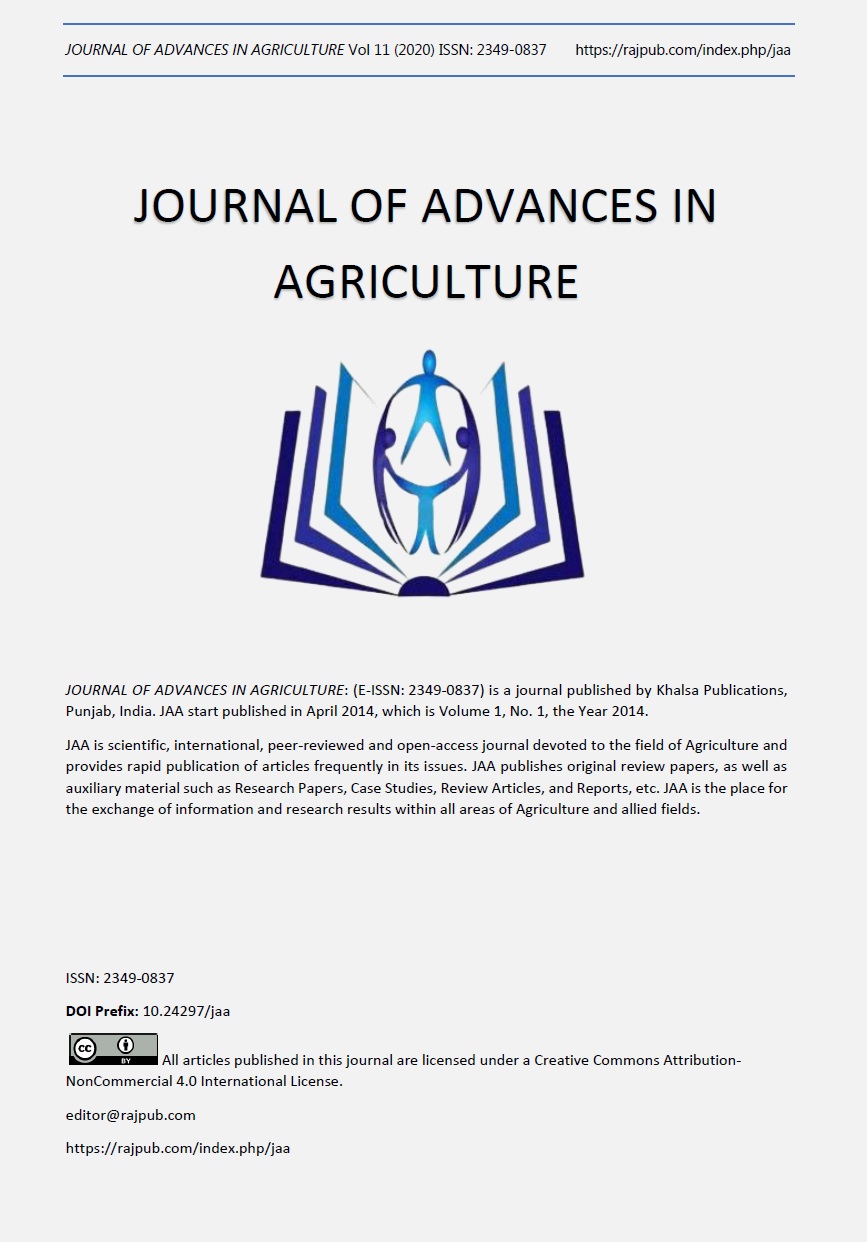Impact of insect pollinators on yields of Glycine max L. (Fabaceae) at Yaoundé (Cameroon) Douniaa, Clautin Ningatoloumb, Chantal Doukaa, Elono Azang Pierre Stephana, Amada Brahimc, Joseph Lebel Tamessea, Fernand-Nestor Tchuenguem Fohouod
DOI:
https://doi.org/10.24297/jaa.v11i.8797Keywords:
Yield Glycine Max, Pollination, Insects, FlowersAbstract
To appreciate the impact of insect pollinators on the pod, seeds, and seed weight yields of Glycine max, the pollinating activities of flowering insects were studied in Yaoundé, during the two mild, rainy seasons in 2016 and 2017 (March-June). Observations were made on 45 to 20400 flowers per treatment. The flowers were subjected to different treatments: Free flowers (Treatment 1), bagged flowers (treatment 2), castrated and free flowers (treatment 3), and castrated and bagged flowers (treatment 4). Some (8695 and 3325) flowers of Glycine max (Fabaceae) were observed in 2016 and 2017, respectively, for the diversity and Frequency of insect visits. For results, 1527 visits of 13 insect species distributed in seven orders were recorded on G. max flowers. The most dominating Hymenoptera observed was Apis mellifera, with 40.20 % of the total insect visits. The highest number of insect pollinators harvested in the flowers of this Fabaceae was between 8h-9h. The studied insects have a positive impact on the yields of this plant. This positive impact of the pollinator insects on the yields was 26.29 %, 16.13 %, 15.02 and 4.45 % in fructification rate, number of seeds pod, the weight of seeds, and percentage of normal seeds respectively. The avoidance of pesticide treatment of plants during flowering could be a good management strategy to improve on plant yield.
Downloads
References
Borror D. J., White R. E. (1991) : Les insectes de l’Amérique du Nord (au nord du Mexique). Broquet (ed.), Laprairie, 408 p.
Eardley C. D., Kuhlmann M., Pauly A. (2010) : Les genres et sous-genres d’abeilles de l’Afrique subsaharienne. ABC Taxa 9, 152 p.
Gallais A., Bannerot H. (1992) : Amélioration des espèces végétales cultivées. INRA, Paris. p.768.
Hymowitz T. (1970) : On the domestication of the soybean. Econ. Bot. 24 (4) : 408-421.
Kengni S. B., Tchuenguem F. F. - N., Ngakou A. (2015) : Impact of the foraging activity of Apis mellifera adansonii Latreille (Hymenoptera : Apidae) and Bradyrhizobium fertilizer on pollination and yield components of Glycine max L. (Fabaceae) in the field. International Journal of Biological Research 3 (2) : 64 - 71.
Kengni B. S. (2017) : Impact des insectes anthophiles et des rhizobia sur les rendements fruitiers et grainiers de Vigna unguiculuta L. et de Glycine max L. (Fabaceae) à Ngaoundéré Cameroun. Thèse de Doctorat/Ph. D., Université de Ngaoundéré, 200 p.
Milfont M. O., Rocha E. E. M., Lima A. O. N., Freitas B. M. (2013) : Higher soybean production using honeybee and wild pollinators, a sustainable alternative to pesticides and autopollination. Environ. Chem. Lett. 11(4) :335-341.
Delaplane K. S., Dag A., Danka G. R., Breno M., Freitas M. B., Garibaldi L., Goodwin R., Hormaza J. 2013. Standard methods for pollination research with Apis mellifera. Journal of Apicultural Research 52 (4): 1- 18.
Dounia, Amada B., Douka C., Elono A. S. P., Ningatoloum C., Belinga B. R., Gagni A. F., Fomekong F., Tamesse J. L., Tchuenguem F. F.-N. (2018) : Foraging Activity of Apis mellifera L. (Hymenoptera: Apidae) on Corn Panicles at Yaoundé, Cameroon. Canadian Journal of Agriculture and Crops 3(2): 64- 71.
Dounia (2015) : Activités de butinage et de pollinisation de Apis mellifera, Lipotriches collaris et Macronomia vulpina (Hymenoptera : Apoidea) sur les fleurs de Glycine max L. (Fabaceae) et Gossypium hirsutum L. (Malvaceae) à Mayel-Ibbé (Maroua, Cameroun). Thèse de Doctorat/Ph.D., Université de Ngaoundéré, 173 p.
MINADER, 2012. Annuaire des Statistiques du Secteur Agricole, Campagnes 2009 & 2010. Direction des Enquêtes et Statistiques. Agri - Stat Cameroun n° 17, 123 p.
Pauly A. (1998) : Hymenoptera Apoidea du Gabon. Annales Sciences Zoologiques 282 : 1-121.
Rortais A., Arnold G., Halm M. P., Touffet B. F. (2005) : Modes of honeybees exposure to systemic insecticides: estimated amounts of contaminated pollen and nectar consumed by different categories of bees. Apidologie 36 (1): 71-83.
Taimanga, Tchuenguem F. F. - N. (2018) : Diversité des insectes floricoles et son impact sur les rendements fruitiers et grainiers de Glycine max (Fabaceae) à Yassa (Douala, Cameroun), International Journal of Biological and Chemical Sciences 12 (1) : 141 - 156.
Tchuenguem F. F.-N., Dounia (2014) : Foraging and pollination behavior of Apis mellifera adansonii Latreille (Hymenoptera: Apidae) on Glycine max L. (Fabaceae) flowers at Maroua. Journal of Research in Biology 4(1) : 1209-1219.
Tchuenguem F.F.-N. (2005) : Activité de butinage et de pollinisation d’Apis mellifera adansonii Latreille (Hymenoptera : Apidae, Apinae) sur les fleurs de trois plantes à Ngaoundéré (Cameroun) : Callistemon rigidus (Myrtaceae), Syzygium guineense var. macrocarpum (Myrtaceae) et Voacanga africana (Apocynaceae). Thèse de Doctorat d’État, Université de Yaoundé I, 103 p.
Tien H. H., Hien T. M., Son M. T., Herridge D. (2002) : Rhizobial Inoculation and N2 fixation of soybean and mungbean in the Eastern region of South Vietnam. In” inoculants and nitrogen Fixation of legumes in Vietnam”. Edited by D. Herridge. ACIAR proceedings 109e.
USDA (2002) : Oilseeds : World markets and trade. Foreign Agricultural Service. Circular series FOP.
Woodworth C. M. (1922) : The extent of natural cross-pollination in soybeans. Jour. Amer. Soc. Agron. 14 : 278-283.
Downloads
Published
How to Cite
Issue
Section
License

This work is licensed under a Creative Commons Attribution 4.0 International License.
 All articles published in Journal of Advances in Linguistics are licensed under a Creative Commons Attribution 4.0 International License.
All articles published in Journal of Advances in Linguistics are licensed under a Creative Commons Attribution 4.0 International License.




